The Stories That Sustain Us: Past, Present, and Future
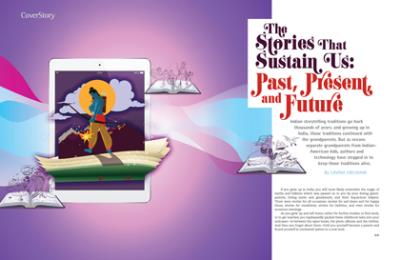
Indian storytelling traditions go back thousands of years; and growing up in India, those traditions continued with the grandparents. But as oceans separate grandparents from Indian- American kids, authors and technology have stepped in to keep those traditions alive.
If you grew up in India, you will most likely remember the magic of myths and folklore which was passed on to you by your doting grandparents, loving aunts and grandaunts, and their loquacious helpers. There were stories for all occasions: stories for sad times and for happy times, stories for mealtimes, stories for bedtime, and even stories for monsoon evenings.
As you grew up and left home, either for further studies, to find work, or to get married, you haphazardly packed these childhood tales into your suitcases—in between the spice boxes, the photo albums and the clothes. And then you forgot about them. Until you yourself became a parent and found yourself in uncharted waters in a new land.
Looking to bring up your own children and safeguard them, you hunted for a talisman which would make them brave, take heart, and always be resilient. And you remembered those long-forgotten tales and rummaged through the suitcases of your mind to reprieve the lives of kings and queens, and the stories of selfhood and courage. And so, parents repeated tales from the Mahabharata, the Ramayana and the Panchantatra; shared poems and songs which had delighted them in their own childhood; and called for the Amar Chitra Katha comics and the Chandamama magazines from homes in India for children growing up in a world of American television and cinema, and of books which never portrayed any Indian characters.
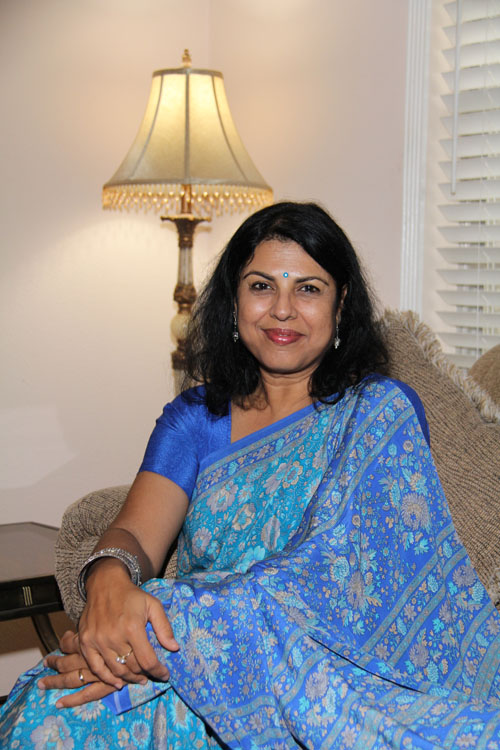
One person who has lived in both these worlds is Chitra Banerjee Divakaruni, noted writer-poet and the immigrant world’s storyteller-in-chief. An immigrant herself, she has become the balladeer of the Indian diaspora, chronicling the struggles, the losses, and the tales of reinvention and redemption. She has put into words what millions of immigrants would find hard to articulate, especially the dilemmas faced by women who move from the confines and traditions of home into the brave new universe outside. Arranged Marriage, her first book of short stories won the American Book Award as well as the PEN Josephine Miles Award for fiction.
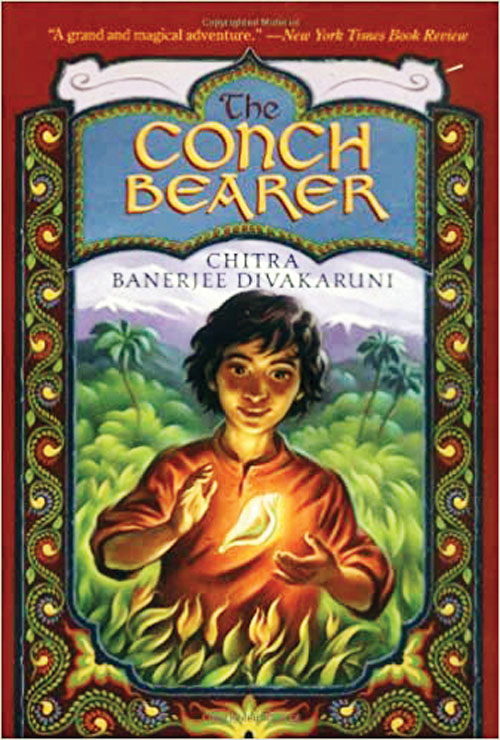 [Left] Chitra Banerjee Divakaruni, the immigrant world’s storyteller-in-chief, has written several children’s books: Neela: Victory Song, The Conch Bearer, The Mirror of Fire and Dreaming, Shadowland, and Grandma’s Great Gourd.
[Left] Chitra Banerjee Divakaruni, the immigrant world’s storyteller-in-chief, has written several children’s books: Neela: Victory Song, The Conch Bearer, The Mirror of Fire and Dreaming, Shadowland, and Grandma’s Great Gourd.
And through all this, Divakaruni hasn’t forgotten the stories she heard and read as a child, and the impact they had. Which is why she has also not forgotten to write for children too. “My maternal grandfather—the only grandparent I had—was a great storyteller,” she recalls. “I certainly credit the evenings he spent telling me tales from the epics with igniting my interest in characters from the Mahabharat and the Ramayana, who later appear in my novels Palace of Illusions and Forest of Enchantment.”
Growing up, Divakaruni read a lot of Bengali authors. “I remember reading Rabindranath Tagore (we had his complete works), Sharat Chandra, Ashapurna Devi. I also read Bibhutibhushan Bandopadhyay whose novel Pather Panchali made me weep.” In her school library, she read English books from Dickens and Thackeray to Tolkien. She also read a lot of Enid Blyton but had a love-hate relationship with her as she grew older. “I loved her stories and characters, but they were all set in England. I wanted adventure books set in India. That may have been a latent reason for me writing children's books later that had Indian characters as heroes in them.”
Divakaruni has written quite a few books for children: Neela: Victory Song, The Conch Bearer, The Mirror of Fire and Dreaming, Shadowland, and Grandma’s Great Gourd. Her books also promote universal values through an Indian lens, such as patriotism in Neela: Victory Song, and compassion and courage in The Conch Bearer which has become part of many schools’ curricula. “When I made school visits, I noticed that South Asian students in the class felt additional empowerment as they were considered authorities on the culture depicted in the book!” she says. She believes it is important for children to see themselves and their culture portrayed in a complex and positive manner. “It is very important for all of us as humans to be validated through our presence in art.”
For young women growing up in America, Divakaruni’s protagonists in her novels hit home. What is she trying to pass on to young girls and women through her novels and short stories? “I want my Indian and Indian-American readers to learn about their history and culture. I want young women of all backgrounds to empathize with my heroines whom I have tried to make into complex personalities, a mix of positive and negative traits. I want them to see women who face trouble and problems of many kinds, but don't give up or break down.”
Like Divakaruni, many Indian-Americans who have grown up here have turned authors of children’s books to bring the much needed Indian-American stories to their children. Interestingly, these new writers have taken on the legacy of their parents and grandparents, but have also added their American heritage to it, building a bridge between the two cultures. They also make feminism, gender-based equality, multiculturalism, and Black Lives Matter (BLM) a part of the narrative for these children's books.

[Top] The storytellers featured in the Indian American Arts Council (IAAC) Literary Festival in 2019. One of them was Veera Hiranandani whose book The Night Diary was a 2019 Newbery Honor Award winner and was named a 2018 Best Book of the Year by The New York Times.
Anu Sehgal is the founder of The Culture Tree, an organization which promotes children’s literature and culture through museums. “Growing up in India, I remember spending long nights on our terrace especially when we used to have electricity outage for hours, and there was nothing else to do but tell stories and share experiences,” she says. “I got very different type of stories from both my parents, since they had different religions and had grown up in different parts of India. I also loved attending festivals and performances such as the Ramleela where art, dance, music, and performance converged.” This led Sehgal to introduce interactive sessions and the performance of Ramleela through puppets at the Indian American Arts Council (IAAC) Literary Festival last year. The festival also had awards for young people in a literary contest about growing up bicultural in America. There was also a superb line-up of Indian-American authors who, through their children’s books, address issues of roots, growth, racism, and identity. All these authors are finding positive answers for their own young children in a changing country.
[Bottom] Roopa Pai’s Taranauts is India’s first original fantasy-adventure series for children in English. She has also written the award winning The Gita For Children, which was listed by Amazon among its list of “100 Indian Books To Read In A Lifetime.”
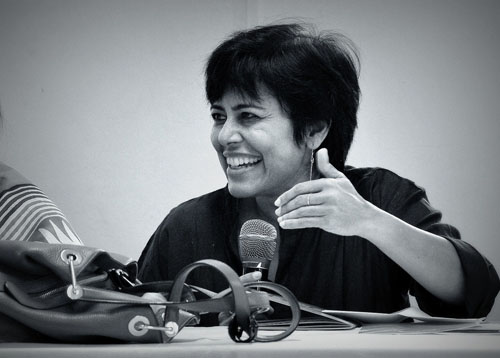
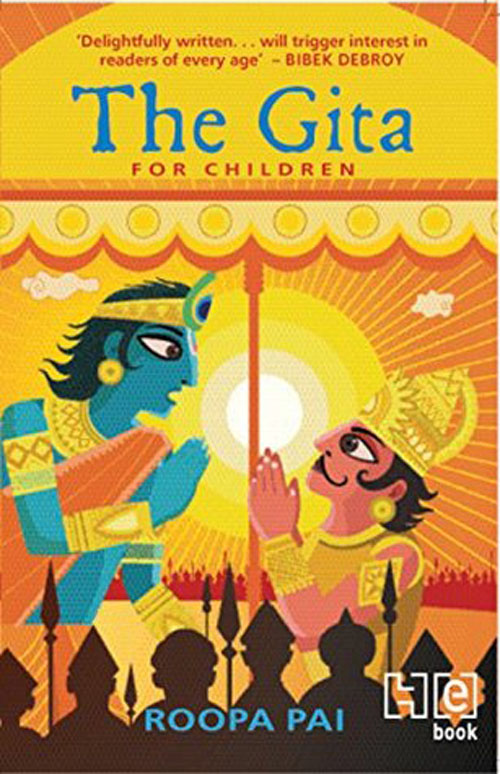
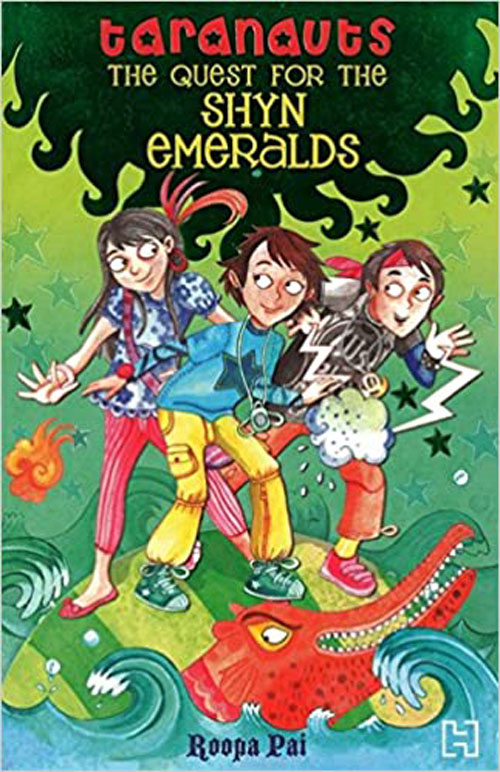
The authors included Veera Hiranandani whose book The Night Diary was a 2019 Newbery Honor Award winner and was named a 2018 Best Book of the Year by The New York Times. Another author at the festival was noted actor Sheetal Sheth with her first children’s book, Always Anjali which won the 2019 Purple Dragonfly Book Award Grand Prize.
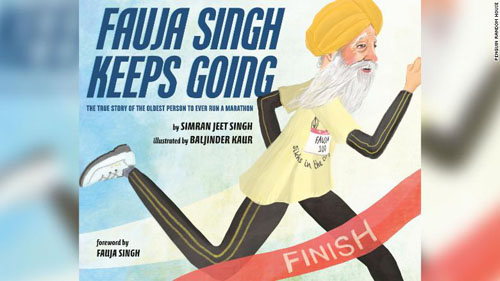
In Fauja Singh Keeps Going, Simran Jeet Singh tells the inspiring true story of Fauja Singh, who broke world records to become the first one-hundred-year-old to run a marathon.
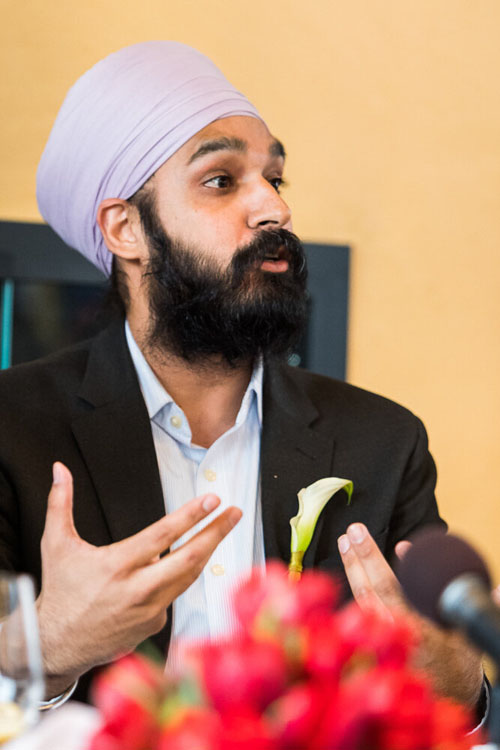 Author and activist, Simran Jeet Singh has written Fauja Singh Keeps Going which tells the inspiring true story of Fauja Singh, who broke world records to become the first one-hundred-year-old to run a marathon. It shares valuable lessons on spunk and grit as it recounts his determination to overcome obstacles, including a birth defect that prevented him from walking until age five. The book is also a commitment to positive representation of the Sikh community. Anu Sehgal says, “The book is the first children’s book by a major publisher to focus on a Sikh story and is produced by an all-South Asian team. The book tour has been featured in several libraries and schools, and the book has even become NYPL bookclub favorite.”
Author and activist, Simran Jeet Singh has written Fauja Singh Keeps Going which tells the inspiring true story of Fauja Singh, who broke world records to become the first one-hundred-year-old to run a marathon. It shares valuable lessons on spunk and grit as it recounts his determination to overcome obstacles, including a birth defect that prevented him from walking until age five. The book is also a commitment to positive representation of the Sikh community. Anu Sehgal says, “The book is the first children’s book by a major publisher to focus on a Sikh story and is produced by an all-South Asian team. The book tour has been featured in several libraries and schools, and the book has even become NYPL bookclub favorite.”
Being brown and proud is the new mantra for first generation Indian-Americans. Raakhee Mirchandani, an award-winning writer, editor, and pediatric cancer crusader, wrote Super Satya Saves the Day inspired by her own spunky daughter Satya, a cancer survivor. As she told diversebooks.com in an interview, “When my husband Agan first saw the cover art for Super Satya, he couldn’t believe that a dad like him was going to be on the cover of a children’s book. What he meant was that he couldn’t believe a dad with a turban was going to be on a book cover. So, while I set out to write this story for Satya, I suppose I also wrote it for Agan and myself. We didn’t have books like this as children; and seeing the incredible response around this one from kids of varied ethnicities and genders really opens my heart.” Her new book Hair Twins explores the hair tales of her husband and her daughter. The book’s illustrations are deliciously and proudly brown.
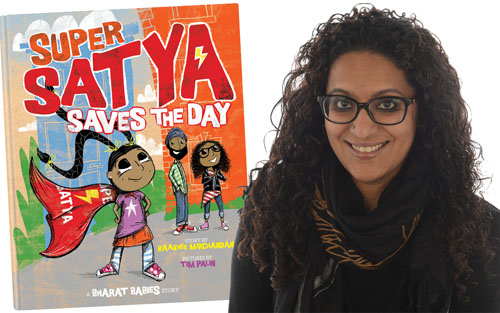
[Left] Raakhee Mirchandani, an award-winning writer, editor, and pediatric cancer crusader, wrote Super Satya Saves the Day inspired by her own spunky daughter Satya, a cancer survivor.
Brown women are now a feisty and ever-increasing club, proclaiming their heritage. Mirchandani has recently started Brown Mom, a podcast about desi culture in which she talks with other women like her. Indeed, we are increasingly moving from print books to digital and audio books, podcasts, apps, and games. Sandhya Nankani is a founding member of Kids' Inclusive and Diverse Media Action Project (KIDMAP), a grassroots coalition of media professionals committed to representation in digital content for children. She started out as a children’s author, influenced by the tales she heard from both her grandmothers—one in Pune, India and the other in Ghana, Africa. She heard stories of her Sindhi heritage, of the Sikh gurus, and tales from the Ramayana. She is also the founder of Literary Safari, an independent children’s media studio and consulting firm, and creates inclusive media for children and families. It has produced award-winning books, apps, and games; and has UNESCO, Sesame Workshop, Scholastic, and PBS as its clients.
Young Indian-Americans are also forming their own publishing companies to produce the kind of content they want to share with the mainstream and their own children. As Sailaja Joshi, CEO of Mango and Marigolds Press, an independent publishing company, says on her site, “There are five times as many books about trucks and twice as many books about bunnies than there are about any children of color.” By highlighting the work of young Indian-American authors, Joshi hopes to right this situation. Founded in 2014, the company has produced 14 books across 4 product categories showcasing South Asian stories. Some of its titles are Bravo Anjali, Little Jagadish and the Great Experiment, and Sarla in the Sky.
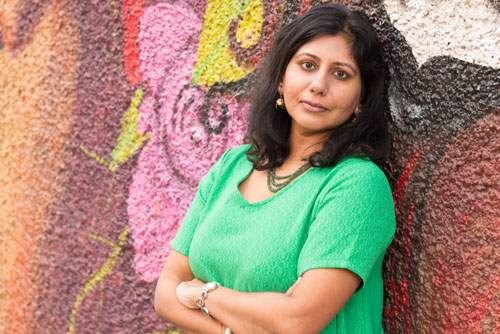
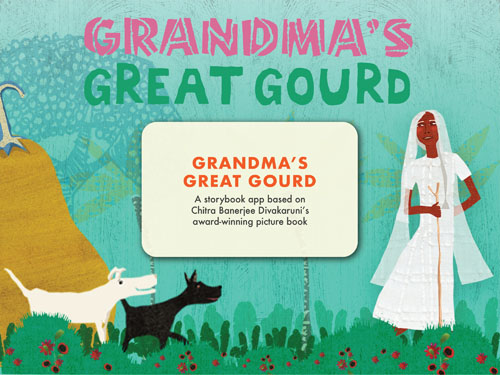
[Right] Sandhya Nankani is a founding member of Kids’ Inclusive and Diverse Media Action Project (KIDMAP), a grassroots coalition of media professionals committed to representation in digital content for children. She is also the founder of Literary Safari, which has produced award-winning books, apps, and games; and has UNESCO, Sesame Workshop, Scholastic, and PBS as its clients.
[Left bottom] Through an app by Literary Safari, Chitra Divakaruni’s Grandma’s Great Gourd can be personalized by a grandmother or a parent recording it in their own voice and language so that a child can watch an animated replay of the story but in the voice of her own grandma or mother.
Indeed, times have changed from those tentative beginnings when there was no literature for Indian-American children. The world is now full of representative stories and there are also so many different ways of telling those stories—orally, in print, online, videos, podcasts, and games. New innovations are being made all the time. As Nankani explains: through an app by Literary Safari, Chitra Divakaruni’s Grandma’s Great Gourd can be personalized by a grandmother or a parent recording it in their own voice and language so that a child can watch an animated replay of the story but in the voice of her own grandma or mother. “When kids read a story they like, they go back to it over and over again, and now they can replay it in their mother’s or grandmother’s voice.I think what technology does beautifully is allow for joint engagement for parents, caregivers, and kids from different generations to gather around a story that perhaps time and space doesn't allow,” she says.
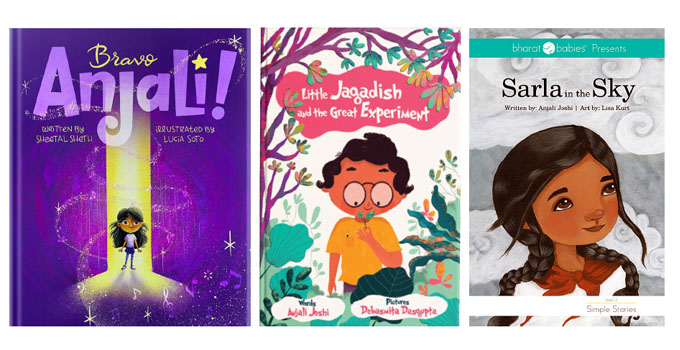
Some of the titles of Mango and the Marigold Press are Bravo Anjali, Little Jagadish and the Great Experiment, and Sarla in the Sky. CEO of the Press, Sailaja Joshi wanted to remedy the lack of representation of children of color in mainstream books.
Authors from India also gave American children a taste of their homeland. Kavita Bafana introduced Namaste Jaipur, as part of her Namaste series of books. Roopa Pai is the author of the eight-part Taranauts, India’s first original fantasy-adventure series for children in English, and the award winning The Gita For Children, which was listed by Amazon among its list of “100 Indian Books To Read In A Lifetime.” She has also created classes for adults and kids where she teaches lessons from ancient texts such as the Vedas and the Upanishads. She says, “They are as relevant in the 21st century as they were four millennia ago. Children face the same issues in the schoolroom and the playground as they always have—isolation, inadequacy, powerlessness, peer pressure, the need to conform—and these ancient texts, believe it or not, can help them deal with all of these.”
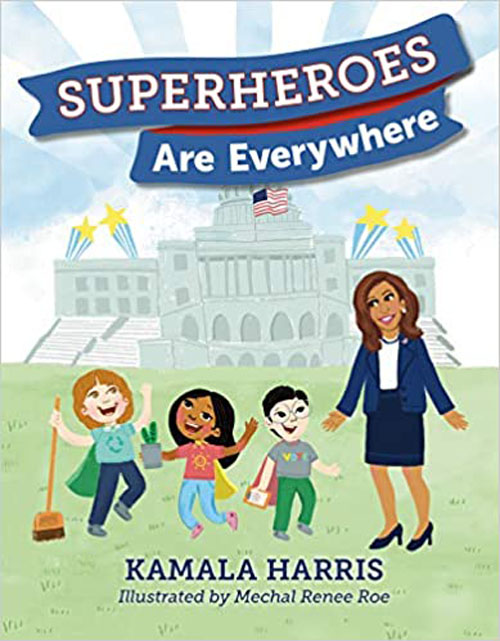
While Indian values are important to these writers, so are universal global values. The Story Seeds Podcast created by Nankani matches kids and their story ideas with storytellers who grow their “story seeds” into original short stories embracing different cultures and communities. Says Nankani, “I think identity helps us, but I think identity also divides us.”
Indian-Americans will continue to mix the past and the present, and tell stories for the next generation—urging them on to a promising future; and blended and multicultural families will be part of that mix. After all, the biggest inspiration is Kamala Harris who too has written a children’s book, Superheroes are Everywhere!
The biggest inspiration in this trend is Vice-President Elect Kamala Harris, who too has written a children’s book, Superheroes are Everywhere!
Lavina Melwani is a writer for several publications and blogs at Lassi with Lavina. Follow her at @lavinamelwani.
Enjoyed reading Khabar magazine? Subscribe to Khabar and get a full digital copy of this Indian-American community magazine.
blog comments powered by Disqus










